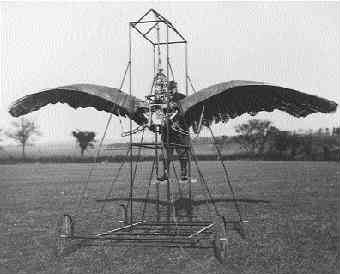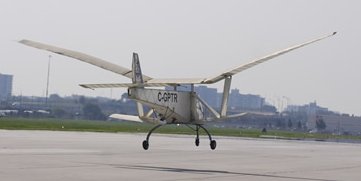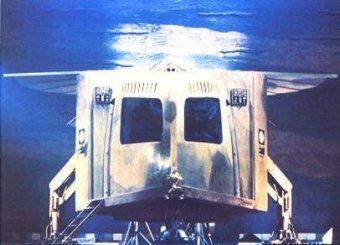ornithopter

Edward Frost of Cambridgeshire, England, made an ornithopter of willow, silk, and feathers in 1902. Frost was later president of the Royal Aeronautical Society.

Flight of the DeLaurier ornithopter on July 8, 2006.

Ornithopter in the 1984 film Dune based on Herbert's book.
An ornithopter is a flying machine that uses flapping wings. Leonardo da Vinci drew pictures of ornithopters in his famous sketchbooks, and several early-twentieth-century attempts at powered flight were ornithopter variants. Some ornithopters were propelled with oars; others used the arms and legs of the occupants for power. Some ornithopters were to be used with the aid of an inflated balloon. The word comes from the Greek words for bird and wing.
Unfortunately for their inventors, flapping wings are only effective given the high power-to-weight ratio of avian muscle.
History of ornithopters
The ancient Greek myth of Daedalus and Icarus tells the tale of how Daedalus made wings of wax and feathers so that he and his son Icarus could escape from captivity. But Icarus flew too close to the sun and his wings melted, while Daedalus flew too low and crashed into the rocks. Both died in their attempts to fly. Another early story tells of King Bladud, who ruled in Britain in the 9th century BC Bladud supposedly constructed a pair of wings with which he proposed to fly. But, according to the monk Geoffrey of Monmouth in a history of the British kings, Bladud was dashed to pieces as he landed on top of the Temple of Apollo in the town of Trinovantum.
Earlier, in 1010, a monk in Malmsesbury, England, attached artificial wings to his body and jumped from the top of his abbey to glide to only two broken legs upon landing. Other tower jumpers suffered death or injuries, while a few achieved some partial success with their glides.
In fifteenth-century Italy, Leonardo, who understood some of the basic principles of flight as early as the 1480s, was the first to seriously study aerodynamics. He examined the way birds flew and sketched their wings and muscles in a flying position. His notebooks were filled with drawings and descriptions of birds in flight and with models that had wings like birds. Unfortunately, his ornithopter and helicopter designs could never have left the ground with them. He, and others of his time, failed to realize that human beings lacked the necessary muscle power to imitate bird flight with flapping wings. His works were rediscovered in the 19th century and had little or no influence on the history of flight technology.
Almost four hundred years after Leonardo, the French inventor Gustave Trouvé designed an ornithopter that was powered by an internal combustion engine. In 1870, Trouvé's unmanned model successfully flew a distance of 70 meters in a demonstration before the French Academy of Sciences. Another Frenchman, Alphonse Pénaud, pioneered the use of rubber band-powered motors in a small ornithopter built and flown in 1874. This established the template for subsequent model ornithopters, differing only in detail and materials.
In 1929, a human-powered ornithopter designed by the German aviation pioneer Alexander Lippisch was towed into the air and, upon release, performed powered glides. This research was complemented by published papers describing Lippisch's theories for flapping-wing flight. Thirty years later, in England, Emil Hartman also built a human-powered ornithopter that was towed into the air (by car), and then released to perform powered glides. This didn't have the same theoretical complement as Lippisch's work, but it was a respectable effort in that it demonstrated the definition of a true ornithopter being birdlike, but not being a slavish copy of a bird. In the 1960s, the American Percival Spencer developed a remarkable series of engine-powered free-flight ornithopter models. These were made in various sizes, with different engine sizes, and are clearly an original accomplishment.
Today, ornithopter designs are still on the minds, as well as the drawing boards, of adventurous and imaginative people determined to achieve the old dream of flight with flapping wings. Some success has been achieved recently toward a practical ornithopter by James DeLaurier and his team at the University of Toronto Institute for Aerospace Studies. With the help of four research students, test pilot Jack Sanderson and a few other volunteers, DeLaurier achieved his lifelong dream of flying a full-scale ornithopter on 8 July 2006, at Downsview Park, Toronto. Equipped with a 24-horsepower engine and a model airplane turbo booster, the Project Ornithopter vehicle flew for 14 seconds at an average speed of 88 kilometers per hour, in the process traveling a third of a kilometers.
Ornithopters in science fiction
Ornithopters have occasionally featured in science fiction. They appear prominently in Frank Herbert's Dune novels. Herbert calls them by the abbreviated term 'thopters.
He broke off as the Duke kicked on the jet brakes. The ship bucked as its tail pods whispered to silence. Stub wings elongated, cupped the air. The craft became a full 'thopter as the Duke banked it, holding the wings to a gentle beat, pointing with his left hand off to the east beyond the factory crawler.
In the Star Trek Voyager episode "Concerning Flight", Captain Janeway and a holographic Leonardo da Vinci escape alien pursuers in a redesigned version of Leonardo's ornithopter with fixed wings and broader wingspan.


